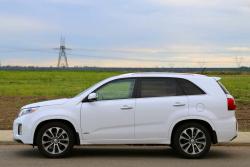 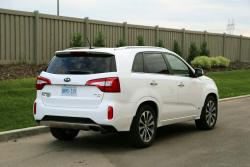 2014 Kia Sorento SX. Click image to enlarge |
Review and photos by Tom Sedens
Hey, didn’t I just review one of these? Seems like it. But that was the 2013 Sorento, and this is the new 2014 model, which has brought some improvements to the table.
I reviewed the SX trim, which is the top of the line. It’s loaded to the gills and there are no options available.
Though the Sorento’s side profile remains relatively unchanged, that’s a good thing. It’s a very nice shape that I enjoyed. Nothing spectacular, but it will age well and its solid, broad-shouldered stance looks good.
Walk around to the front and you’ll see where the nipping and tucking started. The SX gets a signature sport grille and there are significantly revised Xenon HID headlights with an integrated strip of LED running lights. The fog lights below received a makeover too.
Head to the rear end and you’ll see that it got a big re-do as well. The new sculpted dual-depth liftgate looks great – especially when it’s augmented by the SX-trim-specific LED lightbar taillights. They look really good at night. The whole thing is tied together with a freshened bumper and a meaty oval exhaust outlet.
While the 2013’s wheels were nice, I loved the bigger and much more handsome machined-finish 19-inch rims on the 2014, now shod with 235/55 rubber.
Of note: though it’s instantly recognizable as a Sorento, the 2014 model sports a new chassis under the skin.
The changes for 2014 aren’t just skin deep. Under the hood lurks a new smaller-displacement but more powerful 3.3L V6. It’s rated at 290 horsepower at 6,400 rpm (an increase of 14 over last year) and 252 lb-ft of torque at 5,200 rpm (that’s up a hair over last year too). The power gets sent through a six-speed automatic transmission to an all-wheel-drive system.
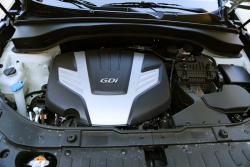 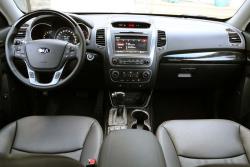 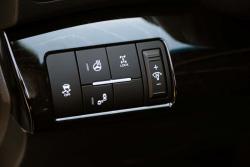 2014 Kia Sorento SX. Click image to enlarge |
Fuel economy is rated about the same – 11.9 L/100 km in the city and 8.4 L/100 km on the highway. I managed to improve my average fuel consumption, burning 14.2 L/100 km during my week with it. This was a very typical week for us – commuting, occasional freeway driving and one quick highway run.
The Sorento’s interior is a very nice place to be. The overall styling of the dash remains similar to the previous model. Although I was disappointed to find no soft-touch plastics anywhere on the dash, the materials have wonderful visual textures and are very nice to look at. The fit and finish was excellent throughout the vehicle and there were no rattles or creaks at any time.
The leather seats – both heated and cooled (last year’s only allowed the driver to have his royal behind cooled) and both power adjustable – are very comfortable and actually provide a bit of bolstering too. There is a two-position driver side memory setting as well.
The heated steering wheel has buttons for the media system, phone, driver information system, hands-free and cruise control. Behind it is a gauge bin. The left side holds the tach, the right side the fuel and temperature gauges. The real story is what’s in the middle. It’s an extremely sharp screen – it actually took me a few minutes to realize it wasn’t a real gauge. This screen makes up a speedometer and a driver information screen in the centre. You can access your media information, navigation system, vehicle information, fuel economy and trip meter data.











